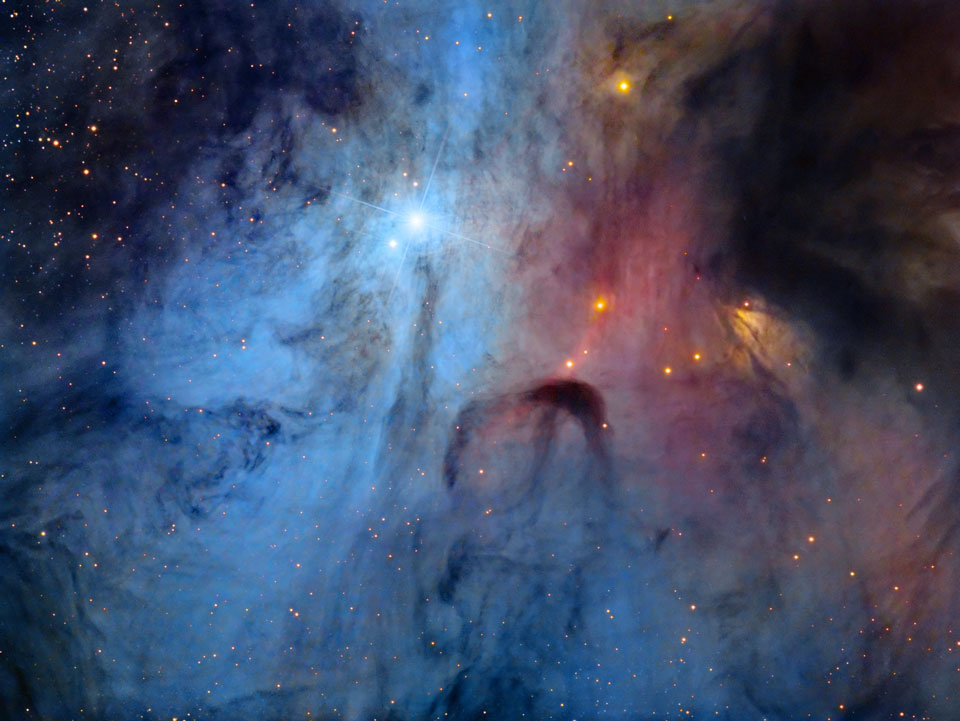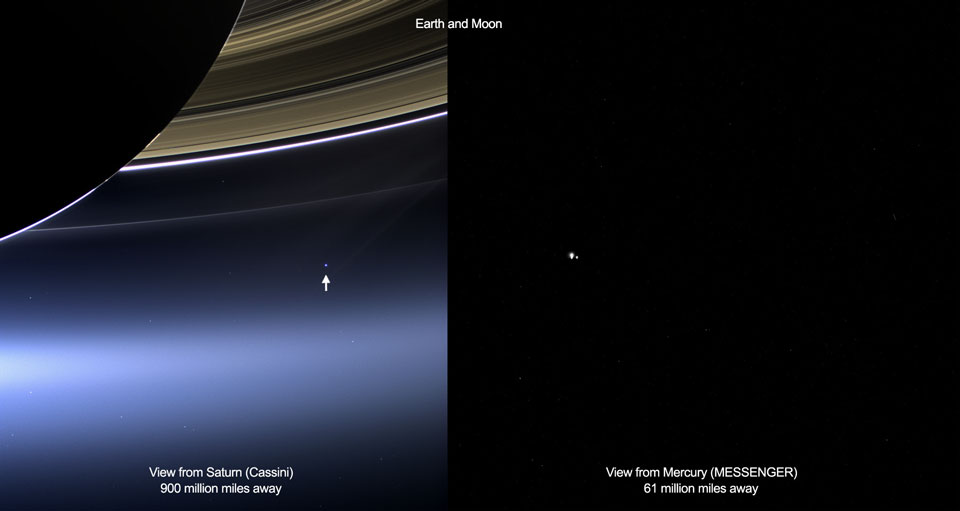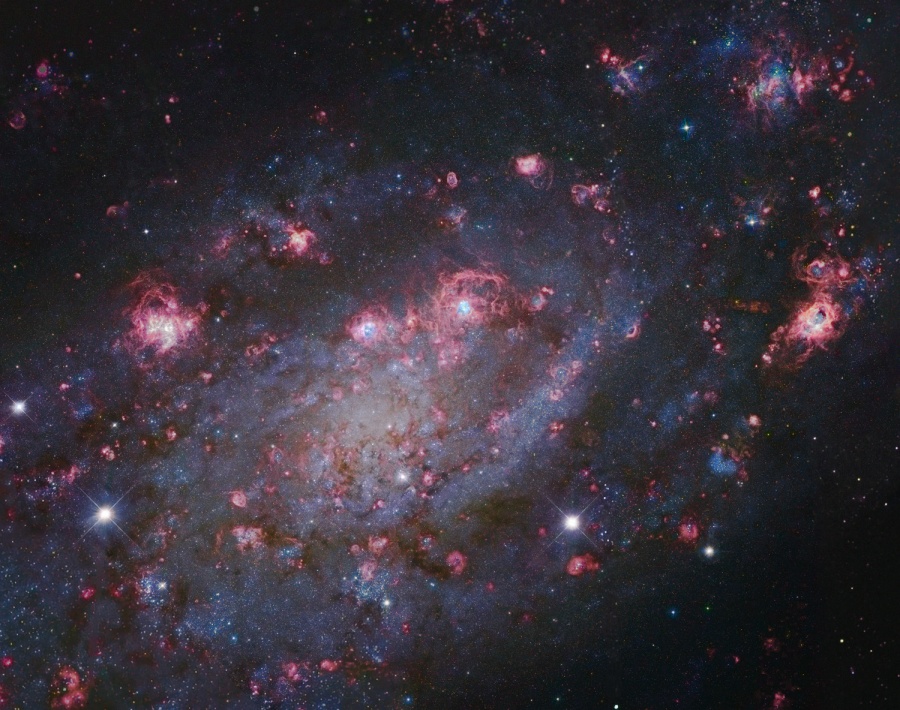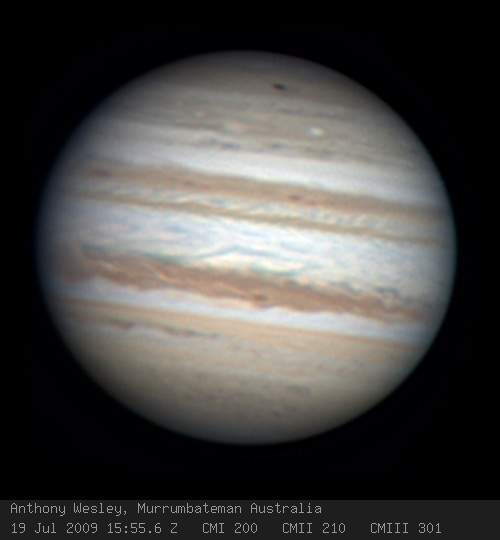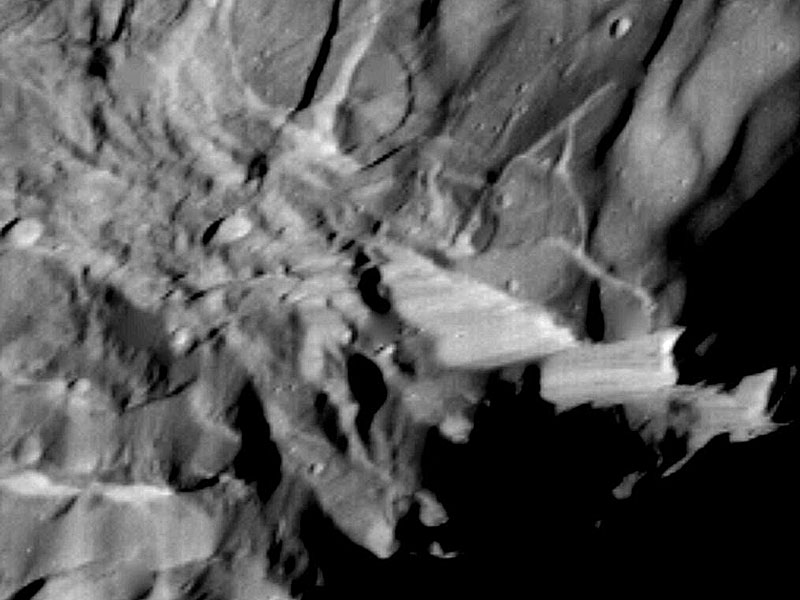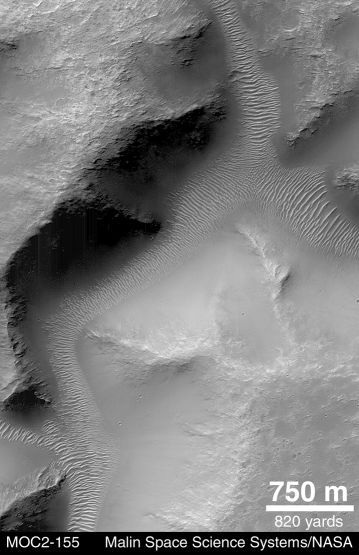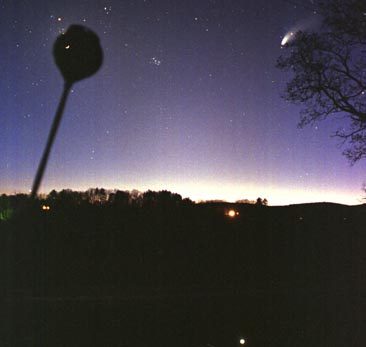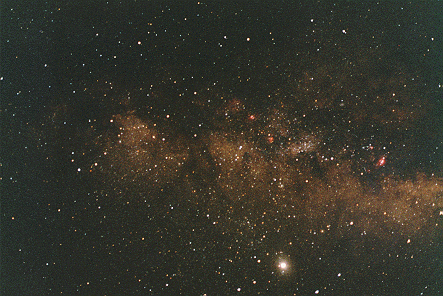| << Previous | Index | Next >> |
2015
[imghover6=http://apod.nasa.gov/apod/image/1507/Co ... le_960.jpg]http://apod.nasa.gov/apod/image/1507/Co ... otated.jpg[/imghover6]Image Credit & Copyright: Amit Kamble (Auckland Astronomical Society); Rollover Annotation: Judy Schmidt
2014 Why does this starfield photograph resemble an impressionistic painting? The effect is created not by digital trickery but by large amounts of interstellar dust. Dust, minute globs rich in carbon and similar in size to cigarette smoke, frequently starts in the outer atmospheres of large, cool, evolved stars. The dust is dispersed as the star dies and grows as things stick to it in the interstellar medium. Dense dust clouds are opaque to visible light and can completely hide background stars. For less dense clouds, the capacity of dust to preferentially reflect blue starlight becomes important, effectively blooming the stars blue light out and marking the surrounding dust. Nebular gas emissions, typically brightest in red light, can combine to form areas seemingly created on an artist's canvas. Photographed above is the central part of the nebula IC 4603 surrounding the bright star SAO 184376 (actually 8th magnitude) which mostly illuminates the blue reflection nebula. IC 4603 can be seen near the very bright star Antares (1st magnitude) toward the constellation of Ophiuchus.
2013
2012
Video Credit & Copyright: Tom A. Warner, ZTResearch, weathervideoHD.TV
2011 Magnificent island universe NGC 2403 stands within the boundaries of the long-necked constellation Camelopardalis. Some 10 million light-years distant and about 50,000 light-years across, the spiral galaxy also seems to have more than its fair share of giant star forming HII regions, marked by the telltale reddish glow of atomic hydrogen gas. In fact, NGC 2403 closely resembles another galaxy with an abundance of star forming regions that lies within our own local galaxy group, M33 the Triangulum Galaxy. Of course, supernova explosions follow close on the heels of the formation of massive, short-lived stars and in 2004 one of the brightest supernovae discovered in recent times was found in NGC 2403. Easy to confuse with a foreground star in our own Milky Way Galaxy, the powerful supernova is seen here as the spiky, bright "star" at the left edge of the field. This stunning cosmic portrait is a composite of space and ground-based image data from the Hubble Legacy Archive and the 8.2 meter Subaru Telescope at the summit of Mauna Kea, Hawaii.
2010 "Nebula at the right foot of Andromeda ... " begins the description for the 76th object in Charles Messier's 18th century Catalog of Nebulae and Star Clusters. In fact, M76 is one of the fainter objects on the Messier list and is also known by the popular name of the "Little Dumbbell Nebula". Like its brighter namesake M27 (the Dumbbell Nebula), M76 is recognized as a planetary nebula - a gaseous shroud cast off by a dying sunlike star. The nebula itself is thought to be shaped more like a donut, while the box-like appearance of its brighter central region is due to our nearly edge-on view. Gas expanding more rapidly away from the donut hole produces the fainter loops of far flung material. The fainter material is emphasized in this composite image, highlighted by showing emission from hydrogen atoms in orange and oxygen atoms in complementary blue hues. The nebula's dying star can be picked out in the sharp false-color image as the blue-tinted star near the center of the box-like shape. Distance estimates place M76 about 3 to 5 thousand light-years away, making the nebula over a light-year in diameter.
2009 In July of 1994 pieces of Comet Shoemaker-Levy 9 collided with planet Jupiter. The explosive impacts sent plumes of debris high into the Jovian atmosphere creating dark markings or scars, visible for a time against the cloud bands. Remarkably, 15 years later, another impact scar was discovered in the Jovian atmosphere by amateur astronomer Anthony Wesley as he examined images of the gas giant taken from his home observatory just outside Murrumbateman NSW Australia. Jupiter's south pole is at the top in this July 19 discovery image, with Jupiter rotating from right to left. The dark marking, also likely caused by a comet or asteroid impact, is near the top of the view, left of a pre-existing, whitish, oval-shaped storm. NASA's Infrared Telescope Facility images from Mauna Kea, Hawaii later confirmed the likely impact site's dark scar and plume of particles in Jupiter's upper atmosphere. Since 2006, major discovery observations by amateur astronomers have also included two red spots on Jupiter.
2008 What created this great cliff on Mars? Did giant waterfalls once plummet through its grooves? With a four-kilometer drop, this high cliff surrounding Echus Chasma, near an impressive impact crater, was carved by either water or lava. A leading hypothesis is that Echus Chasma, at 100-kilometers long and 10-kilometers wide, was once one of the largest water sources on Mars. If true, water once held in Echus Chasma likely ran over the Martian surface to carve the impressive Kasei Valles, which extends over 3,000 kilometers to the north. Even if initially carved by water, lava appears to have later flowed in the valley, leaving an extraordinarily smooth floor. Echus Chasma lies north of tremendous Valles Marineris, the largest canyon in the Solar System. The above image was taken by the robotic Mars Express spacecraft currently orbiting Mars.
2007 Could you survive a jump off the tallest cliff in the Solar System? Quite possibly. Verona Rupes on Uranus' moon Miranda is estimated to be 20 kilometers deep -- ten times the depth of the Earth's Grand Canyon. Given Miranda's low gravity, it would take about 12 minutes for a thrill-seeking adventurer to fall from the top, reaching the bottom at the speed of a racecar -- about 200 kilometers per hour. Even so, the fall might be survivable given proper airbag protection. The above image of Verona Rupes was captured by the passing Voyager 2 robotic spacecraft in 1986. How the giant cliff was created remains unknown, but is possibly related to a large impact or tectonic surface motion.
2006 Although you've surely seen it, you might not have noticed it. During a cloudless twilight, just before sunrise or after sunset, part of the atmosphere above the horizon appears slightly off-color, slightly pink. Called the Belt of Venus, this off-color band between the dark eclipsed sky and the blue sky can be seen in nearly every direction including that opposite the Sun. Straight above, blue sky is normal sunlight reflecting off the atmosphere. In the Belt of Venus, however, the atmosphere reflects light from the setting (or rising) Sun which appears more red. The Belt of Venus can be seen from any location with a clear horizon. Pictured above, the Belt of Venus was photographed above morning fog in the Valley of the Moon, a famous wine-producing region in northern California, USA. The belt is frequently caught by accident in other photographs.
2005 This gorgeous celestial vista is centered on one of the Milky Way's own planetary nebulae, M57, the famous Ring Nebula. The wide view is a composite of three exposures; one to record the details of the inner roughly one light-year span of the familiar nebula, one to record the surprisingly intricate but faint outer rings of glowing hydrogen gas, and one to pick up the rich assortment of distant background galaxies. By chance, one of the background galaxies, IC 1296 at the upper left, is close enough to show its barred, spiral structure making an attractive visual comparison with M57. Interestingly, though IC 1296 is 200 million light-years away compared to only 2 thousand light-years for M57, a faint ring is also apparent around the outer reaches of the distant spiral galaxy.
2004 What colors are Saturn's rings? Recent images from the Cassini spacecraft now orbiting Saturn confirm that different rings have slightly different colors. The above image shows their sometimes-subtle differences in brightness and color. The rings reflect sunlight and so, even if they were perfectly reflecting, would appear the color of the Sun. The ring particles are mostly light water-ice, although these particles can be shaded by an unknown type of darker dirt. Thinner and more isolated rings also naturally appear darker. The brightest section pictured above is Saturn's B ring.
2003 Why do some places on Earth have higher gravity than others? Sometimes the reason is unknown. To help better understand the Earth's surface, slight distance changes between a pair of identically orbiting satellites named GRACE have been used to create the best ever map of Earth's gravitational field. High points on this map, also colored red, indicate areas where gravity is slightly stronger than usual, while in blue areas gravity is slightly weaker. Many bumps and valleys on the map can be attributed to surface features, such as the North Mid-Atlantic Ridge and the Himalayan Mountains, but others cannot, and so might relate to unusually high or low sub-surface densities. Maps like this also help calibrate changes in the Earth's surface including variable ocean currents and the melting of glaciers.
2002 What would it be like to stand atop the tallest mountain on Earth? To see a full panoramic vista from there, scroll right. Visible are snow peaked mountains near and far, tremendous cliffs, distant plateaus, the tops of clouds, and a dark blue sky. Mt. Everest stands 8.85 kilometers above sea level, roughly the maximum height reached by international airplane flights, but much less than the 300 kilometers achieved by a space shuttle. Hundreds of people have tried and failed to climb the behemoth by foot, a feat first accomplished successfully in 1953. About 1000 people have now made it to the summit. Roddy Mackenzie, who climbed the mountain in 1989, captured the above image. Mt. Everest lies in the Himalayan mountains in the country of Nepal. In the native language of Nepal, the mountain's name is "Sagarmatha" which means "goddess of the sky."
2001 Birds don't fly this high. Airplanes don't go this fast. The Statue of Liberty weighs less. No species other than human can even comprehend what is going on, nor could any human just a millennium ago. The launch of a rocket bound for space is an event that inspires awe and challenges description. Pictured above, the Space Shuttle Atlantis lifted off to visit the International Space Station during the early morning hours of July 12. From a standing start, the two million kilogram rocket ship left to circle the Earth where the outside air is too thin to breathe and where there is little noticeable onboard gravity. Rockets bound for space are now launched from somewhere on Earth about once a week.
2000 Sir Isaac Newton changed the world. Born in 1643, Newton was only an above-average student. But he went home from Cambridge one summer in 1665, thought a lot about the physical nature of the world, and came back two years later with a revolutionary understanding of mathematics, gravitation, and optics. A Professor of his, upon understanding what Newton had done, resigned his own position at Cambridge so Newton could have it. Newton's calculus provided a new mathematical framework for the rapid solution of whole classes of physical problems. Newton's law of gravitation explained in one simple formula how apples fall and planets move. Newton's insights proved to be so overwhelmingly powerful he was the first scientist ever knighted.
1999 This tantalizing close-up detail of a network of martian valleys was recorded from orbit this April by Mars Global Surveyor's camera. Water may once have flowed here but now sand dunes stripe the windswept valley floor. The Mars Global Surveyor spacecraft arrived in orbit in September of 1997 and has been exploring the red planet since. Three other spacecraft, Mars Climate Orbiter, Mars Polar Lander, and Nozomi are presently en route.
1998 This dramatic artist's vision shows a city-sized neutron star centered in a disk of hot plasma drawn from its enfeebled red companion star. Ravenously accreting material from the disk, the neutron star spins faster and faster emitting powerful particle beams and pulses of X-rays as it rotates 400 times a second. Could such a bizarre and inhospitable star system really exist in our Universe? Based on data from the orbiting Rossi X-Ray Timing Explorer (RXTE) satellite, research teams have recently announced a discovery which fits this exotic scenario well - a "millisecond" X-ray pulsar. The newly detected celestial X-ray beacon has the unassuming catalog designation of SAX J1808.4-3658 and is located a comforting 12,000 light years away in the constellation Sagittarius. Its X-ray pulses offer evidence of rapid, accretion powered rotation and provide a much sought after connection between known types of radio and X-ray pulsars and the evolution and ultimate demise of binary star systems.
1997 It was truly a busy sky. In one of the more spectacular photos yet submitted to Astronomy Picture of the Day, Don Cooke of Lyme, New Hampshire caught the Sun, Moon, Earth, night sky, Pleiades star cluster, and Comet Hale-Bopp all in one frame. The first leg of this "triple crown" exposure was of the Sun, taken at 6:55 pm on April 10th 1997. Through a dark filter, the Sun appears as the bright dot on the lower right of the image. A second filtered exposure was then taken after the Sun had set, one hour and 40 minutes later - this time featuring the Moon. The Moon appears as a crescent superimposed on an odd-shaped dark circle protruding into the left of the image. This shadow is actually a silhouette of a driveway reflector mounted on an aluminum rod used to block out the bright moon - so as to allow a third exposure, this time unfiltered, of the background night sky. And what a beautiful sky it is. Highlights include Comet Hale-Bopp, on the right, and the Pleiades star cluster, near the center. But what, you may wonder, is that bright light near the center of the picture? Don't worry if you can't guess: it's a porch light from a house across the river!
1996 Shining brightly, the mighty Jupiter rules this gorgeous Kodacolor photo of the Milky Way near Sagittarius. Astronomer Bill Keel took the picture earlier this month (July 7) while standing near the summit of Hawaii's Mauna Kea contemplating the sky in the direction of the center of the Galaxy (right of picture center). In addition to the gas giant planet, which is well placed for evening viewing, the image contains an impressive sampler of celestial goodies. Many famous emission nebulae are visible as reddish patches - M16, the Eagle nebula, is just above and right of center, with the Horseshoe nebula, M17, just below it and farther to the right. Also, look for the Lagoon Nebula, M8, as the brightest red patch at the right of the picture with the Trifid Nebula, M20, just above it and to the left. The milky glow of distant unresolved stars in the plane of our Galaxy (thus the term Milky Way) runs through the image cut by dark, absorbing, interstellar dust clouds. The much anticipated comet Hale-Bopp is also clearly visible. Where's the comet? Click on the picture to view the comet's location flanked by superposed vertical lines. The comet was discovered while still beyond the orbit of Jupiter a year ago today independently by Alan Hale and Thomas Bopp. Astronomers monitoring Hale-Bopp's activity report that having now brightened to almost 6th magnitude it is still on track for becoming an extremely bright naked-eye comet in early 1997.
1995 The vivid blue and violet colors present in the Trifid Nebula result from the abundance of young stars there. The light from young massive stars is quite blue and has the ability to remove electrons from surrounding gas. When these electrons re-combine with the gas, radiation rich in blue and violet light is emitted. Some of the nebula's light also results from the reflection of star light off of extremely small carbon specks known as 'dust'. This object is known to astronomers as M20 - the twentieth object on Charles Messier's list of diffuse sky objects. This image was taken with a 6-inch refracting telescope.
| << Previous | Index | Next >> |
